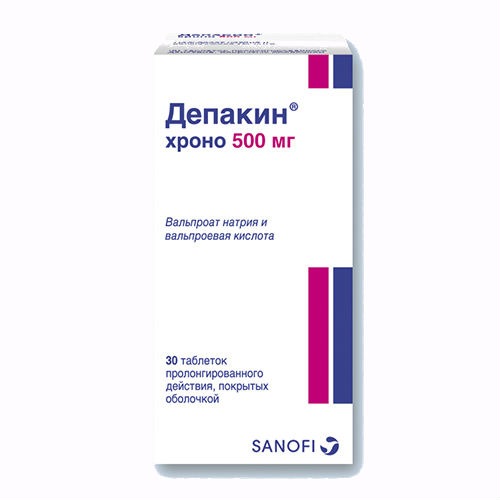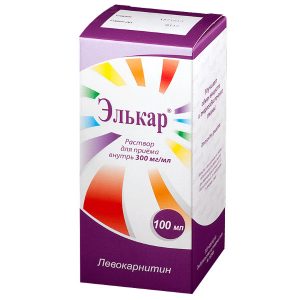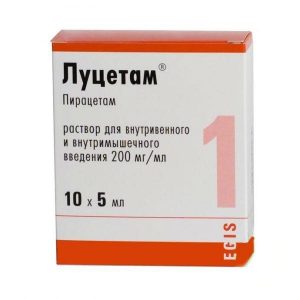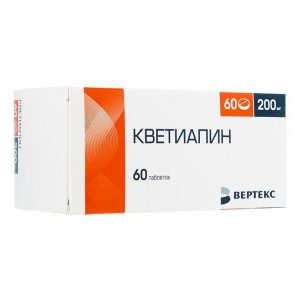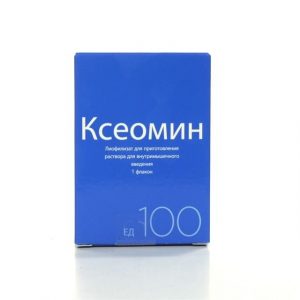Description
Release form
Sustained-release tablets, coated almost white, oblong, with risk on both sides, odorless or with a faint odor.
Packing
30 pcs – polypropylene bottles (1) – packs of cardboard
Pharmacological action
Anticonvulsant drug, has a central muscle relaxant and sedative effect. It exhibits antiepileptic activity in all types of epilepsy.
The main mechanism of action, apparently, is associated with the effect of valproic acid on the GABA-ergic system: the drug increases the GABA content in the central nervous system and activates the GABA-ergic transmission.
Pharmacokinetics
Absorption
The bioavailability of sodium valproate and valproic acid when administered is close to 100%.
When taking Depakin ® Chrono 500 mg tablets at a dose of 1000 mg / day, Cmin in plasma is 44.7 ± 9.8 μg / ml, and Cmax in plasma is 81.6 ± 15.8 μg / ml. Tmax in plasma is 6.58 ± 2.23 h. Css in plasma is reached within 3-4 days of regular administration of the drug.
The average therapeutic range for serum concentrations of valproic acid is 50-100 mg / L. If it is reasonably necessary to achieve higher concentrations of valproic acid in blood plasma, the ratio of the expected benefit and the risk of side effects, especially dose-dependent, should be carefully weighed, because when the concentration of valproic acid is more than 100 mg / l, an increase in side effects is expected until the development of intoxication. With a plasma concentration of valproic acid of more than 150 mg / l, a dose reduction is required.
Compared to the enteric-coated dosage form, the sustained release tablet formulation in equivalent doses is characterized by the absence of latent absorption time, prolonged absorption identical to bioavailability, a lower Cmax value (a decrease in Cmax of about 25%), but with a more stable plateau phase from 4 to 14 hours after administration, a more linear correlation between the dose and the concentration of the drug in plasma.
Distribution of
Binding to plasma proteins (mainly to albumin) is high (90-95%), dose-dependent and saturable.
Vd depends on age and is usually 0.13-0.23 l / kg body weight or in young people 0.13-0.19 l / kg body weight.
Valproic acid penetrates the cerebrospinal fluid and the brain. The concentration of valproic acid in the cerebrospinal fluid is 10% of the corresponding plasma concentration.
Valproic acid passes into breast milk in nursing mothers. In the equilibrium state, the concentration of valproic acid in breast milk is 1-10% of its concentration in plasma.
Metabolism
Metabolized by beta, omega- and omega-1 oxidation and conjugation with glucuronic acid. More than 20 metabolites were isolated, metabolites after omega-oxidation have a hepatotoxic effect.
Valproic acid does not have an inducing effect on isoenzymes of the P450 cytochrome system: unlike most other antiepileptic drugs, valproic acid does not affect the degree of both its own metabolism and the degree of metabolism of other drugs, such as estrogens, progestogens, and indirect anticoagulants.
Excretion
Excreted mainly in urine after beta oxidation and conjugation. T1 / 2 is 15-17 hours. Plasma clearance of valproic acid in patients with epilepsy is 12.7 ml / min.
Pharmacokinetics in special clinical cases
In elderly patients, patients with renal and hepatic insufficiency, binding to plasma proteins is reduced. In severe renal failure, the concentration of the free (therapeutically active) fraction of valproic acid can increase to 8.5-20%.
In case of hypoproteinemia, the total concentration of valproic acid (free + plasma fraction bound to blood proteins) may not change, but it may also decrease due to an increase in the metabolism of the free valproic acid fraction (not bound to blood plasma proteins).
When combined with antiepileptic drugs that induce microsomal liver enzymes, the plasma clearance of valproic acid increases and T1 / 2 decreases. the degree of their change depends on the degree of induction of microsomal liver enzymes by other antiepileptic drugs.
T1 / 2 values in children over 2 months of age are close to those in adults.
In patients with liver disease, valproic acid T1 / 2 increases.
In case of overdose, an increase in T1 / 2 was observed up to 30 h.
Only the free fraction of valproic acid in the blood (10%) undergoes hemodialysis. At the same time, despite taking the drug in a constant dose, a decrease in the concentration of valproic acid in the plasma is possible. In addition, during pregnancy, a change in the degree of binding of valproic acid to plasma proteins is possible, which can lead to an increase in the serum content of the free (therapeutically active) fraction of valproic acid.
Indications
In adults, as monotherapy or in combination with other antiepileptic drugs:
treatment of generalized epileptic seizures (clonic, tonic, tonic-clonic, absences, myoclonic, atonic)
epileptic seizures of paroxysmal seizure with or without secondary generalization)
treatment and prevention of bipolar affective disorders.
In children, as monotherapy or in combination with other antiepileptic drugs:
treatment of generalized epileptic seizures (clonic, tonic, tonic-clonic, absences, myoclonic, atonic)
Lennox-Gastaut syndrome
treatment of partial epileptic seizures (partial seizures with or without secondary generalization).
Contraindications
hypersensitivity to sodium valproate, valproic acid, valproate semisodium, valpromide, or to any of the auxiliary components of the
preparation acute hepatitis
chronic hepatitis
severe liver disease (especially drug hepatitis) in the history of the patient and his close blood relatives
severe liver damage in years acid in close blood relatives of the patient
severe dysfunction of the liver or pancreas
severe dysfunction of the pancreas
hepatic firiya
combination with mefloquine
combination with drugs St. John’s wort
children under 6 years of age (the risk of getting the tablet into the airway during swallowing).
With caution
liver and pancreas diseases with a history of
pregnancy
congenital fermentopathies
inhibition of bone marrow hematopoiesis (leukopenia, thrombocytopenia, anemia)
renal failure (multiple doses required) )
simultaneous administration of drugs that provoke convulsive seizures or lower the threshold of convulsive readiness, such as tricyclic antidepressants, selective and serotonin reuptake inhibitors phenothiazine derivatives, buterophenone derivatives, chloroquine, bupropion, tramadol (risk of convulsive seizures)
simultaneous administration of antipsychotics, MAO inhibitors, antidepressants, benzodiazepines (the possibility of potentiating their effects)
concomitant use of phenobarbital, primidone, phenytoin, lamotrigine, zidovudine, felbamate, indirect anticoagulants, cimetidine, erythromycin, carbapenems, and rifampicin have a relationship with the pharmacopin blood plasma, a change in plasma concentrations of either these drugs and / or valproic acid is possible)
concomitant use with carbamazepine (risk of potentiation of toxin of the natural effects of carbamazepine and a decrease in the plasma concentration of valproic acid)
concomitant use with topiramate (risk of developing encephalopathy).
Use in cases of impaired liver function
The drug is contraindicated in cases of impaired liver function.
Application for impaired renal function
When using Depakine Chrono in patients with renal failure, it may be necessary to reduce the dose of the drug.
Use in children
For children 6 years of age and older, the average daily dose is 30 mg / kg.
Use in elderly patients
In elderly patients, the dose should be set in accordance with their clinical condition.
Use during pregnancy and lactation
During pregnancy, the development of generalized tonic-clonic epileptic seizures, epileptic status with the development of hypoxia can be a risk factor for death for both the mother and the fetus.
Teratogenic effects of valproic acid have been shown in experimental studies of reproductive toxicity in mice, rats, and rabbits.
Available clinical data confirm that in children born to mothers with epilepsy who received valproic acid, there is an increased frequency of occurrence of intrauterine developmental disorders of varying severity (neural tube malformations craniofacial deformities malformations of the extremities, cardiovascular system as well as multiple intrauterine malformations affecting various organ systems) compared with the frequency of their occurrence when pregnant women take some other antiepileptic drugs.
Based on available data, there is an association between the intrauterine exposure to valproic acid and the risk of developmental delay (especially speech development) in children born to mothers with epilepsy who took valproic acid. Delayed development is often combined with malformations and phenomena of dysmorphism. However, in cases of developmental delay in such children, it is difficult to establish a causal relationship with the use of valproic acid due to the possibility of simultaneous exposure to other factors, such as low intelligence of the mother or both parents, genetic, social factors, environmental factors, insufficient treatment, aimed at preventing epileptic seizures in the mother during pregnancy.
It has also been reported on the development of various autistic disorders in children exposed to intrauterine exposure to valproic acid.
Both valproic acid monotherapy and combination therapy with valproic acid are associated with an unfavorable outcome of pregnancy, but combined antiepileptic therapy including valproic acid has been reported to be associated with a higher risk of an adverse pregnancy outcome compared to valproic acid monotherapy.
In connection with the foregoing, Depakin ® chrono should not be used during pregnancy and in women of childbearing age unless absolutely necessary. Its use is possible, for example, in situations where other antiepileptic drugs are ineffective or the patient does not tolerate them.
The question of whether Depakin ® chrono should be used or whether it should be abandoned should be decided before the use of the drug or reconsidered if a woman receiving Depakin ® chrono is planning a pregnancy.
Women of childbearing age should use effective methods of contraception during treatment with Depakin ® chrono. Women of childbearing age should be informed about the risks and benefits of using valproic acid during pregnancy. When prescribing the drug, pregnancy must be excluded.
If a woman is planning a pregnancy or is diagnosed with pregnancy, then the need for valproic acid treatment should be reassessed depending on the indications: for bipolar disorder, consideration should be given to discontinuing treatment with valproic acid
for epilepsy, the question of continuing treatment with valproic acid or its cancellation is decided after reappraisal the ratio of benefit and risk. If, after reviewing the ratio of benefits and risks, a decision has been made to continue treatment with Depakin ® chrono during pregnancy, it is recommended to use it in the minimum effective daily dose, divided into several doses. It should be noted that during pregnancy, the use of sustained release dosage forms is preferred.
One month before conception and within 2 months after it, folic acid (at a dose of 5 mg / day) should be added to antiepileptic treatment, because this can minimize the risk of neural tube malformations.
Continuous special prenatal monitoring should be performed to identify possible malformations of the neural tube or other fetal malformations.
The development of isolated cases of hemorrhagic syndrome of newborns whose mothers took valproic acid during pregnancy was reported. This hemorrhagic syndrome is associated with hypofibrinogenemia and is possibly due to a decrease in the content of blood coagulation factors. Fatal development of afibrinogenemia has also been reported. This hemorrhagic syndrome should be distinguished from vitamin K deficiency, caused by phenobarbital and other inducers of microsomal liver enzymes.
Therefore, in newborns born to mothers receiving valproic acid, platelet counts, plasma fibrinogen concentrations, blood coagulation factors and coagulograms must be determined.
Cases of hypoglycemia have been reported in newborns whose mothers took valproic acid during the third trimester of pregnancy.
Excretion of valproic acid with breast milk is low, its concentration in breast milk is 1-10% of its plasma concentration. Based on literature data and little clinical experience, with monotherapy with Depakin ® Chrono, mothers can plan breastfeeding, but the profile of side effects of the drug should be taken into account, especially hematological disorders caused by it.
Composition
1 tab.
sodium valproate ** 333 mg
valproic acid ** 145 mg
Excipients: colloidal silicon dioxide anhydrous – 4 mg, methylhydroxypropyl cellulose 4000 mPa.s (hypromellose) – 176 mg, ethyl cellulose (20 mPa.s) – 12 mg, saccharin – 10 mg, hydrated colloidal silicon dioxide – 50 mg, methylhydroxypropyl cellulose 6 MPa.s (hypromellose) – 7.2 mg, 30% polyacrylate dispersion – 24 mg, macrogol 6000 – 7.2 mg, talc – 7.2 mg, titanium dioxide – 1.2 mg.
** corresponds to 500 mg of valproic acid in 1 tab.
Dosage and Administration
Depakin ® Chrono is intended only for adults and children over 6 years old with a body weight of more than 17 kg!
Depakin ® chrono is a sustained release dosage form, this avoids sharp increases in the concentration of valproic acid in the blood after taking the drug and for a longer time maintains a constant concentration of valproic acid in the blood during the day.
Long-acting tablets Depakin ® chrono 300 mg or 500 mg can be divided to facilitate the administration of an individually selected dose.
Tablets are taken without crushing or chewing them.
Epilepsy
The doctor selects the daily dose individually.
To prevent the development of epilepsy attacks, the drug should be used in the minimum effective dose (especially during pregnancy).
The daily dose is set in accordance with the age and body weight of the patient. A stepwise (gradual) dose increase is recommended until the minimum effective dose is reached.
No clear association was found between daily dose, plasma concentration, and therapeutic effect. Therefore, the optimal dose should be determined mainly by the clinical response. Determination of plasma valproic acid levels may complement clinical observation if epilepsy is not controlled or if there is a suspicion of side effects. The range of therapeutic concentrations in the blood is usually 40-100 mg / L (300-700 μmol / L).
With monotherapy, the initial dose is usually 5-10 mg of valproic acid per kg of body weight, then this dose is gradually increased every 4-7 days at the rate of 5 mg of valproic acid per kg of body weight to the dose necessary to achieve control over epilepsy attacks.
Average daily doses (with prolonged use):
for children 6-14 years old (body weight 20-30 kg) – 30 mg valproic acid / kg body weight (600-1200 mg)
for adolescents (body weight 40-60 kg ) – 25 mg of valproic acid / kg body weight (1000-1500 mg)
for adults and elderly patients (body weight from 60 kg and above) – an average of 20 mg of valproic acid / kg body weight (1200-2100 mg).
Although the daily dose is determined by the age and body weight of the patient, a wide range of individual sensitivity to valproate should be taken into account.
If epilepsy cannot be controlled at these doses, they can be increased under the control of the patient’s condition and the concentration of valproic acid in the blood. In some cases, the full therapeutic effect of valproic acid does not appear immediately, but develops within 4-6 weeks. Therefore, you should not increase the daily dose above the recommended average daily dose earlier than this period.
The daily dose can be divided into 1-2 doses, preferably with meals.
Use in one step is possible with well-controlled epilepsy.
Most patients who are already taking Depakin ® in non-sustained release dosage form can be transferred to Depakin ® chrono immediately or within a few days, while patients should continue to take the previously selected daily dose.
For patients who have previously taken antiepileptic drugs, the transfer to the administration of Depakin ® chrono should be carried out gradually, reaching the optimal dose of the drug within about 2 weeks. In this case, you should immediately reduce the dose of the antiepileptic drug that the patient took earlier, especially if it is phenobarbital. The withdrawal of the antiepileptic drug that the patient took earlier should be carried out gradually.
other antiepileptic drugs can reversibly induce microsomal liver enzymes, for 4-6 weeks after taking the last dose of these antiepileptic drugs, monitor the concentration of valproic acid in the plasma and, if necessary (as the metabolic inducing effect of these drugs decreases), reduce the daily dose of valproic acid.
If necessary, a combination of valproic acid with other antiepileptic drugs should be added to the treatment gradually.
Manic episodes in bipolar disorder
Adults
The daily dose should be selected individually.
The recommended starting daily dose is 750 mg. In addition, clinical trials also show an acceptable safety profile for an initial dose of 20 mg of sodium valproate per kg of body weight.
Depakin ® Chrono can be taken 1 or 2 times / day. The dose should be increased as soon as possible to achieve the minimum effective therapeutic dose.
The average daily dose is in the range of 1000-2000 mg of sodium valproate.
Patients receiving a daily dose of more than 45 mg / kg / day should be under close medical supervision.
With continued treatment of manic episodes in bipolar disorders, the drug is used in an individually selected minimum effective dose.
Children and adolescents
The efficacy and safety of the drug in the treatment of manic episodes in bipolar disorders in patients under 18 years of age have not been evaluated.
Special patient groups
In patients with renal failure and / or hypoproteinemia, the possibility of increasing the concentration of the free (therapeutically active) valproic acid fraction in the blood serum should be considered, and if necessary, reduce the dose of valproic acid, focusing on the selection of the dose, mainly on the clinical picture, and not on the total content of valproic acid in blood serum (free fraction and fraction associated with blood plasma proteins) in order to avoid possible errors in dose selection.
overdose
Symptoms: coma with muscle hypotension, hyporeflexia, miosis, respiratory depression, metabolic acidosis, cases of intracranial hypertension associated with brain edema have been described. Symptoms may vary, convulsive seizures have been reported at very high plasma concentrations of valproic acid.
A significant overdose may result in a fatal outcome, but usually a favorable prognosis.
Treatment: in the hospital – gastric lavage, which is effective for 10-12 h after taking the drug monitoring and correction of the functional state of the cardiovascular and respiratory systems, maintaining effective diuresis. In some cases, naloxone was successfully used. In very severe cases of significant overdose were effective hemodialysis and hemoperfusion.
Storage conditions
The drug should be stored out of the reach of children, dry place at temperatures below 25 ° C.
Expiration
3 years.
Deystvuyuschee substances
Valproevaya acid
Terms of delivery from pharmacies
Prescription
Dosage form
dosage form
tablets
Sanofi-Aventis, France
